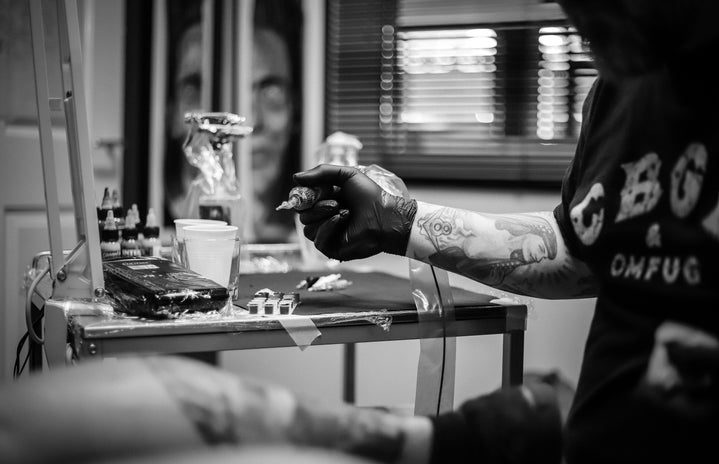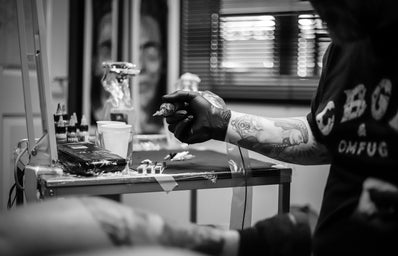Tattooing as a culture has grown exponentially in recent years, with more and more people moving away from treating the practice as taboo worldwide, including in India. Young people all over the country have begun to embrace tattoos and piercings as a part of everyday life, and societal attitudes toward tattoos are slowly but surely changing as well. However, many are unaware of India’s rich history of tattooing, dating as far back as our ancient civilizations. Tattoos were seen as a right of passage in some cultures within the country and symbolised a multitude of different meanings in different cultures.
By far the most well-known of Indian tribes with a rich history of tattooing is the Konyak tribe of Nagaland. The Konyaks were a tribe of warriors and headhunters that saw tattooing as a rite of passage for young men to prove their manhood, and warned rival tribes of their fierce, deadly skill. Members of the tribe tattooed themselves in a painful process that was taught to generations of women in the tribe; First, leaves from the black dhup, or Canarium strictum plant were cleaned and heated over fire until they softened. These leaves were then squeezed to collect the liquid within the plant. The fibrous remains were then burned, and the leftover soot was mixed with the leaf liquid to make the signature dark green ink of their tribe. Then, the design was selected by the tribal king and a tool made from the thorns and stems of the rattan plant was dipped in ink and gently tapped into the skin with a small hammer. This ancient form of tattooing took a day, and in some cases, multiple days to complete, and the healing process was painful, but the symbolism of the tattoos themselves carried a much heavier weight than tattoos today.
Another tribe with a rich history of tattooing is the Rabari tribe of nomadic cattle and camel shepherds that live throughout northwest India, primarily in the states of Gujarat, Punjab and Rajasthan. Known for their beautiful embroidery style, the women of the tribe call their tattoos “Trajva.” Getting a Trajva tattoo is a sign of strength, and a rite of passage. Girls close to getting married get this tattoo done as bare skin is considered shameful. These tattoos are done on many parts of the body like the face, throat, forearms, neck, etc. The most common motifs are scorpions and snakes. The ink they use is made by mixing lamp soot, tannin from the bark of local trees, and a small quantity of turmeric powder to brighten the colour and to prevent swelling. A single heated needle is used to apply these tattoos.
Further south, the Narikuravar tribe in Tamil Nadu is still keeping their traditional method of ‘Pachai Kuthu’ alive. The art of pachai kuthu originally involved tattooing names on the body with ink made from mother’s milk mixed with the soot of lamps and herbal powder made with crushed leaves. While the colour of the ink would be black initially, it would later turn into a shade of dark green. In the Kalmedu region of Tamil Nadu, almost all members of the Narikuravar tribe have their own names and that of the village imprinted on their body. As they travel to different places for days, weeks or months for trade, they depend on the pachai kuthu to help in identifying their bodies in case they were to pass while away from their homes. The Narikuravars also believe the entire body is an easel for the art of pachai kuthu, and that pachai kuthu could heal pain; when people have nagging pain in the forehead, pachai kuthu is done around the temples on both sides to relieve them of the pain, any pain in the knee or ankle is rid of with pachai kuthu on the leg, etc. Now, the artform is mostly lost, but members of the tribe still sell their services near Madurai and other regions of Tamil Nadu, tattooing with commercially available ink and needles.
Many believe that tattooing has lost its artistic and spiritual roots, but many like Mo Naga, a member of the Uipo tribe who continues the practice of traditional Naga tattooing, are keeping its spiritual roots alive by continuing to showcase traditional styles and designs with modern sanitary practices and tools.
Other Indian tattoo artists have also taken inspiration from their roots, with artists like Flying Munki, Swasthi K Iyengar, Chewd Perfect, etc popularizing the art of tattooing in India. More and more Indian people are getting tattoos, and the artform has evolved with more involvement of traditional designs, and inspiration taken from Indian culture.
References:
- https://www.indiatoday.in/interactive/immersive/contemporary-tattoo-culture-know-history-tattoo-types-and-other-details/#:~:text=Permanent%20skin%20tattoos%20have%20been,some%20tribal%20people%20in%20India.
- https://www.thebetterindia.com/58170/india-tattoo-tradition-history/
- https://nobordersjournal.com/stories/tattoojourneywithswasthikiyengar
- https://www.alienstattoo.com/post/tattoos-on-women-a-legacy-that-began-way-ahead-of-time
- https://qz.com/india/1136007/the-konyaks-of-nagaland-indias-famed-tattooed-headhunters-are-a-vanishing-tribe
- https://www.jetir.org/papers/JETIR2009121.pdf

